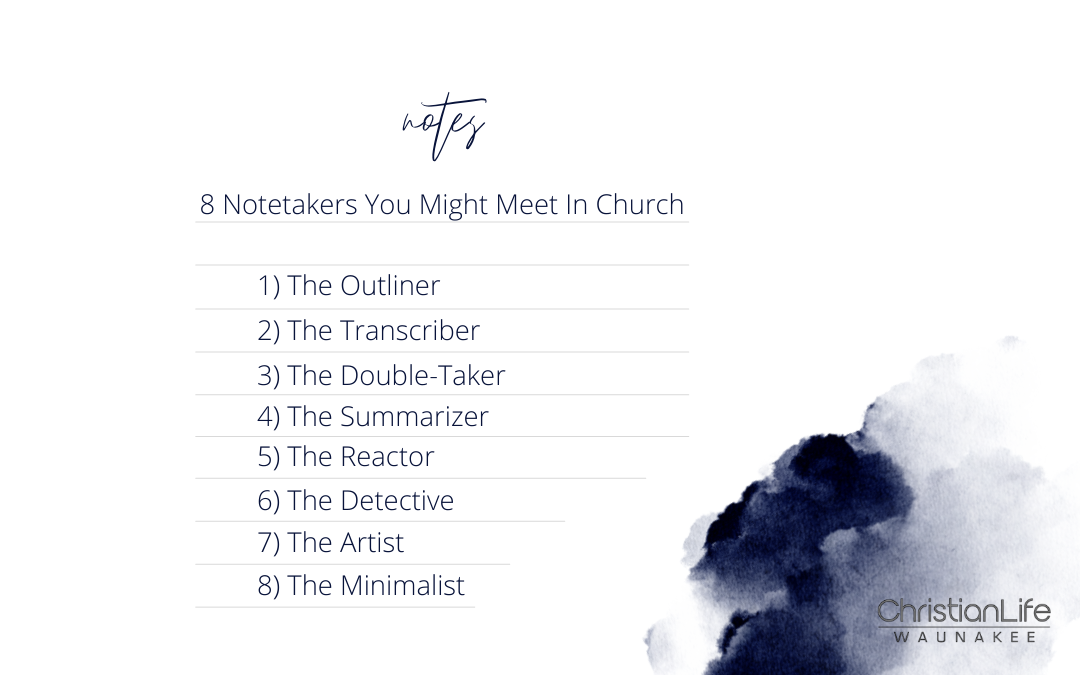When trying to learn and remember something from a class, lecture, or sermon, it’s a good idea to take notes. Not only does notetaking help you pay attention during the message, but you also end up with a page of information to look back on later. But how do you go about taking notes? What do you include, and what do you leave out? How do you organize your notes on the page? Everyone has a different method. Here are eight types of notetaker you might meet in the service at your church:
#1 The Outliner
This organized notetaker’s pages are probably neatly laid out in bullet points for the main sections of the sermon, subpoints, and Bible references. They’ve probably also included the title of the message, the speaker’s name, and the date as well as an outline of the message. Because their notes are so easy to read, when they look back on their notes later, they’ll get a good understanding of the message’s main ideas.
#2 The Transcriber
This type of notetaker is able to write quickly and pay close attention for long periods of time. They need these skills because they prefer to copy down as much of the message as possible sentence by sentence. They may not get every word down, but they’ll have some of the most detailed notes of anyone in the room.
#3 The Double-Taker
The Double-Taker will end up with two sets of notes. The first set they write down during the sermon, not worrying about neatness, spelling, or any of those kinds of detail. Then, they create the second set not too long after the sermon, copying their original notes but making them neater, more organized, and more thought out. By going over the material twice, they’re not likely to forget it in a hurry.
#4 The Summarizer
Extensive notetaking isn’t for everyone. The Summarizer may find that they get distracted by the pressure of taking notes during the sermon and miss some of the message. They prefer to take it all in first, then sit down after the service and write down the main point and key takeaways. They may also note how they’re going to apply what they’ve learned.
#5 The Reactor
This type of notetaker isn’t as concerned with repeating the content of the message as they are in writing down their response to it. Their note pages look like a conversation or dialogue between the speaker and themselves. They may include comments of agreement and disagreement, questions, emotions they felt while listening, and so on. Their notes probably contain lots of question marks, exclamation points, and maybe some hand-drawn emojis too.
#6 The Detective
The Detective loves finding connections between ideas. Their head is filled with ideas that pop up when something seems related, and they’re good at identifying links between different subjects that interest them. Their note pages and the margins of their Bible are often scrawled with notations on related Bible passages, sermons, literature, research, etc.
#7 The Artist
It may look like these notetakers are doodling. But does it really count as doodling if it helps you focus? This type of notetaker engages with the message through drawings, graphs, color-coding, etc. Their notebook may look like an artist’s sketchbook, and their bag probably has at least 12 colors of highlighter or gel pens at the bottom.
#8 The Minimalist
Some people find that they can engage with and remember a message best by not worrying about writing anything down. This listener doesn’t go in with a plan to take notes, but they may keep a notebook or scratch paper handy to scribble down ideas that especially stand out to them. Or, they can always jot down a comment, quote, or question on a napkin, a corner of the bulletin, or even their hand. Whatever works!
Which kind of note taker are you? Maybe you mix strategies from more than one type, or maybe you have a completely different method. We’d love to hear from you in the comments!
—————————————————

